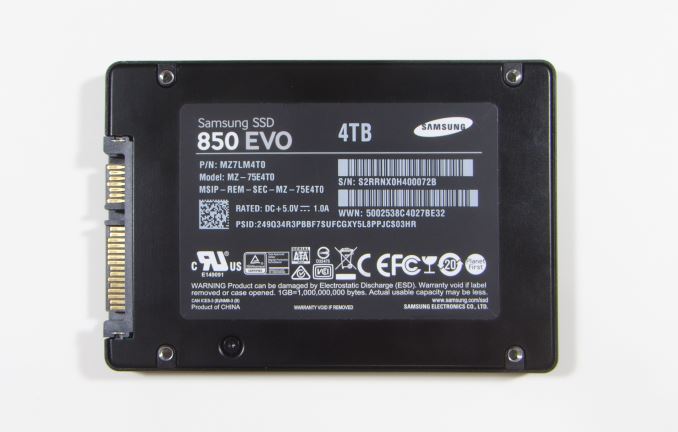The Samsung 850 EVO 4TB SSD Review
by Billy Tallis on July 11, 2016 10:00 AM ESTFinal Words
The 4TB Samsung 850 EVO set new highs for a few performance sub-tests, but ultimately the only important record it breaks is for its storage capacity. On that front it is without equal in the consumer market and even among enterprise SATA drives higher capacities are only available from drives that are more than 7mm thick.
Samsung's new 256Gb 48-layer V-NAND chips made it straightforward for them to create this product, but it doesn't quite seem necessary. We were already quite impressed with their 2TB drives, and they still don't face any serious competition. The 4TB 850 EVO is a stark illustration of Samsung's seemingly insurmountable lead in the marketplace, but it is far too expensive for any ordinary desktop or NAS use. There simply aren't many consumers who can afford this much SSD, but if you're a consumer with the budget for 4TB of SSD storage the 850 EVO can deliver it in a single 2.5" drive with none of the complexity of RAID. The drive may also be very welcome in the professional video space, but the relatively low write endurance rating of 300TB (75 total drive writes) could scare off those customers.
Putting aside the concerns about the suitability of this drive for today's market, it is a good sign for the future. Samsung is finally putting their new generation of 3D NAND on shelves in large quantities. As promised it doesn't seem to bring any new performance issues, but a SATA drive can't really prove that conclusively. The improvements to power efficiency are modest but real and every bit of that will be welcome as the 48-layer V-NAND finds its way into the rest of the product line. It is hard to tell whether the new V-NAND will be pushing prices much lower in the short term, but it looks like it will at least be competitive with what's already out there. Samsung is well positioned to continue their dominance for another round.
The 4TB 850 EVO also gives us another light push towards a future where mechanical hard drives are gone from the consumer market. Building a SSD that can entirely displace hard drives is now possible using controllers and DRAM that are cheap commodity parts. (SSDs larger than 4TB could be made using two controllers plus a RAID controller at the cost of some peak performance, a technique used by drives like the 2TB Mushkin Reactor TC.) The per-GB price of NAND flash is the only front on which SSDs still need to improve; SSDs have far surpassed mechanical hard drives in performance and power consumption and have caught up in terms of capacity and density.
The performance of the 4TB 850 EVO also makes it clear that there is even less need for a 4TB 850 Pro. An MLC counterpart simply isn't needed to reach the highest speeds that can be expected of a SATA drive, because 3D TLC drive done right and in such abundant capacity is plenty fast. The only reason Samsung should bother shipping a 4TB 850 Pro is if they're going to give it a vastly higher write endurance rating for a small price premium. Otherwise, they should save that new 3D MLC for the PCIe drives.











145 Comments
View All Comments
nandnandnand - Monday, July 11, 2016 - link
Weren't the first XPoint parts going to be 16-32 GB? I find $0.65/GB hard to believe... I expect $3.00/GB.nathanddrews - Monday, July 11, 2016 - link
Yeah, I'll believe it when I see it.Kevin G - Monday, July 11, 2016 - link
Where are you seeing this and for what format?I strongly suspect that Intel is going to be price competitive in the NVMe space so that's realistic but I'd expect a massive premium for Xpoint in DIMM format when Skylake-E comes around.
shabby - Monday, July 11, 2016 - link
Why would xpoint dimm be premium priced? They said its slower than dimm, so it should be cheaper.Kevin G - Monday, July 11, 2016 - link
Well what competition would the DIMM format have on SkyLake-E?SATA based SSDs are a dime a dozen and M.2 drives using NVMe are just starting to spread. What competition would Intel have with a DIMM format?
Impulses - Monday, July 11, 2016 - link
There's a lot of pie in the sky dreaming about Xpoint IMO... Why would it be priced at a premium? Same reason M.2 NVMe & PCI-E drives are, it's what the market will bear that counts. If it's any faster it'll be more expensive, simple really.ddriver - Monday, July 11, 2016 - link
Don't hold your breath. They made claims of "ram" speed, but demoed 2 GB/s hardware, which is not much faster than nvme SSDs. Ram is 20-30 GB/s...SSDs can still go a long way in terms of bandwidth - just snap more chips on more channels, given an available interface to hook it to, it would be too much trouble for the industry to create something like 8 GB/s SSD. And it only requires a better controller chip, can work with the same old flash memory chips. Currently, M2 can only provide theoretical 4 GB/s bandwidth, running at 32 gbit.
Eden-K121D - Monday, July 11, 2016 - link
a PCIe gen4 device could have potential read speeds of 8GB/sKevin G - Monday, July 11, 2016 - link
The 2 GB/s demo was using a Thunderbolt enclosure and an M.2 prototype.Full size PCIe and DIMM formats are planned so I'd consider that 2 GB demo the starting point.
benedict - Monday, July 11, 2016 - link
Horrible write endurance. If you need a drive that big you certainly have enough data to fill it 75 times.